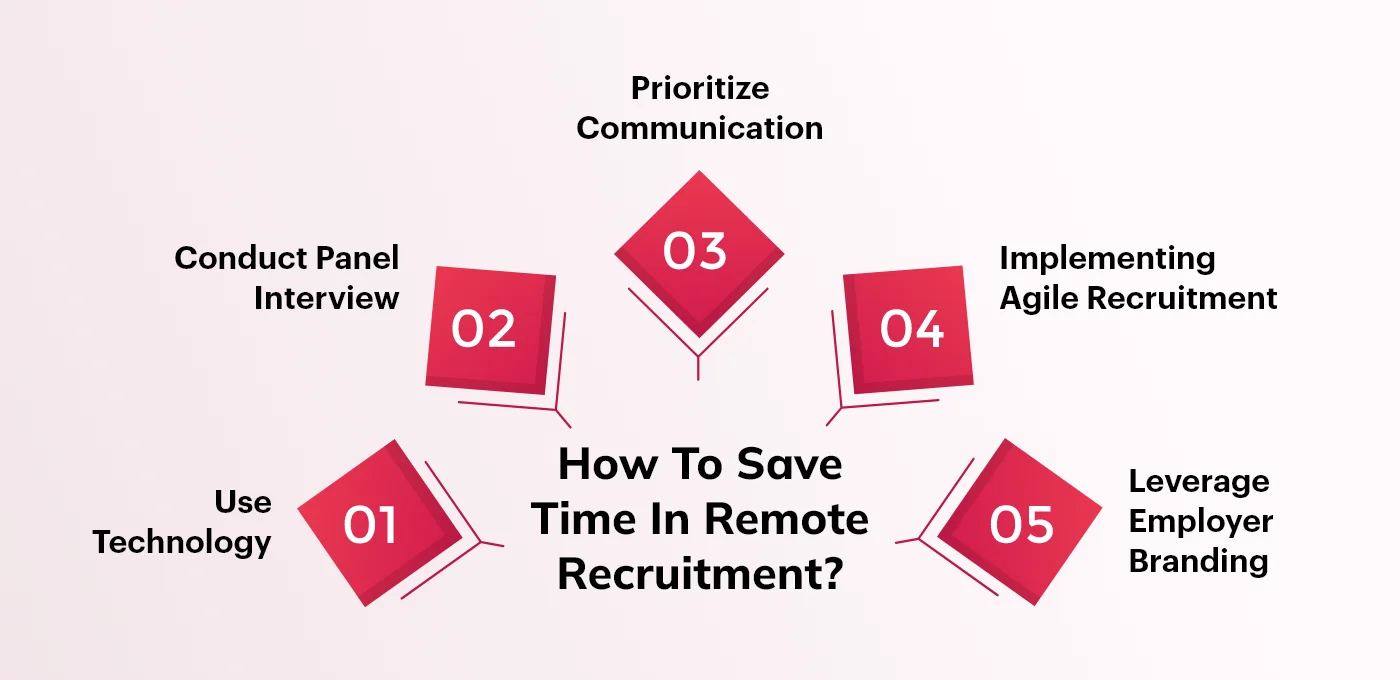Tips To Hire and Save Time In Remote Recruitment
- July 9, 2024
- 8 mins
- 17.5k

With the increasing trend of remote working, companies are changing their processes and the way they hire new employees to accommodate this shift. This shift brings both challenges and opportunities to improve how companies work. Getting upright at remote hiring can help companies enhance their productivity and efficiency.
However, remote recruitment comes with its own challenging points. When you can’t interact face-to-face, it’s tough to figure out if someone’s a good fit for the team, if he/she has good communication skills, or have quality traits to handle things. Besides, it requires careful planning and execution to coordinate schedules across different time zones and manage virtual interviews.
The traditional hiring process usually involves lots of interviews, tests, and background screening, which takes a long time. Every step a candidate takes in your hiring process is fortified by the ticking clock of time to hire. If the process is going too long or taking more time to tell the results, it might deter top talent, and lose the interest of a good candidate in the particular company.
The latest study shows that 62% of professionals lose interest in a job if they don’t get any feedback within 2-3 weeks after the initial interview, from the company in which they have given the interview. This percentage would increase to 75-77% if there is no update within 3-4 weeks.
This clarifies that time is the most important factor to hire the best talent and secure the position. And, prioritizing a speedy hiring process enhances candidate satisfaction and also, impacts organizational success.
In this blog, we’ll talk about how to save time in remote recruitment.
Average Time to Hire for Remote Positions Vs. In-House
The average time to hire for remote positions and in-house rolls around the overall duration, from posting remote or in-house vacancies to onboarding a new team member in the company.
The first step to hiring a remote or in-house employee is to identify the needs of their role. This may be due to a new job role, an existing employee quitting, or the need to expand the workforce.
The average time for in-house recruitment is 4-6 weeks. While the positions to be filled remotely requires 2-6 weeks. The remote positions have comparatively a shorter time of hire due to tech-based streamlined processes and a broader pool of resources.
In the process of hiring remote aspirants, there are a few stakeholders and decision-makers, resulting in leeway and swift decision-making.
Top Ways to Save Time in Remote Recruitment

Here are the top ways to save time in remote recruitment. Read below how you can streamline the process and find the best talent faster.
1. Use Technology
Technology rationalizes the entire recruitment process. Remote recruitment influences the latest technology tools! Utilizing applicant tracking systems, video conferencing tools, and AI-driven screening platforms can eliminate unnecessary delays and modernize the hiring process.
-
Applicant Tracking System
The tracking system automates the screening and tracking of candidates. It allows recruiters to manage applications more efficiently. These systems can filter applications based on predefined criteria, saving valuable time by prioritizing candidates who best match the job requirements.
-
Video Conferencing Tools
These tools facilitate virtual interviews, enabling recruiters to assess candidates remotely. Zoom, Skype, or Microsoft Teams are common platforms offering great features like screen sharing and recording. It ensures seamless communication and so, enhances the overall interview experience.
-
AI-driven Screening Platforms
Such platforms use AI/ML algorithms and NLP to analyze resumes and assess the skills and qualifications of candidates. These tools can quickly identify top candidates as per the predetermined criteria, advancing the initial screening process, reducing manual effort, and saving time.
2. Conduct Panel Interview
Organizations should streamline the recruitment process to accelerate hiring without compromising on hiring the right skillset person. One approach is conducting panel interviews in which several stakeholders can interview the candidate simultaneously. It reduces the number of interviews rounds and leads to improved decision-making.
Furthermore, asynchronous video interviews let candidates answer preset questions whenever they have time. Recruiters can watch these recordings whenever they fit their schedule, avoiding conflicts and speeding up the screening process.
3. Prioritize Communication
Good communication is key for remote hiring to go smoothly. Keeping in touch with candidates regularly keeps them in the loop. Giving feedback quickly, whether it’s good or needs improvement, shows respect. Also, being clear about how long the hiring process might take helps manage expectations and reduces confusion. Being honest builds trust and makes the company more appealing to great candidates.
4. Implement Agile Recruitment Strategies
Agile recruitment methods use ideas from agile project management to stay flexible and responsive. By dividing the hiring process into small steps, recruiters can keep improving. Sprint-based recruitment sets short-term goals, like one or two weeks, to stay on track. Team reviews help spot what’s working well and what could be better, so they can tweak their methods.
5. Leverage Employer Branding
Having a good reputation as an employer is a powerful tool for getting talented people on board quickly. Companies should share what makes them special—like their culture, values, and what their employees say—on social media, forums, and career sites.
A recent study found that 34% of companies are using smart career websites to find talented workers, and 26% are thinking about using one in the year 2025 and beyond.
Talking to candidates on social media, like LinkedIn, helps build connections and lets them know about job openings. When employees also share about the company, it spreads the word even more and gives a good impression to potential candidates.
Examples of Companies that have Expedited Project Timelines through Faster Remote Staffing
Explore how companies use remote staffing to accelerate projects! Dive into their success stories and strategies for faster timelines.
- Google: The tech giant – Google has reformed its project management method by working with remote teams in different time zones. By teamwork through digital platforms, Google has expedited the development timelines of several products and services.
- Amazon: With its complex network of remote workers, Amazon has exceeded geographical boundaries to fast-track its project timelines. Through simulated communication tools and streamlined workflows, the e-commerce company has optimized its operational efficiency.
- Upwork: Upwork is a prime online marketplace for freelancers. It provides an extensive range of professionals and experienced profiles in different domains. Companies can post project requirements on Upwork and quickly hire remote freelancers based on their skill sets and availability.
- Toptal: Toptal helps businesses partner with top freelance experts in design, development, finance, and project management. Companies can find experts fast, forming remote teams on this platform, tailored to their project needs and speeding up timelines.
- Fiverr: Fiverr is a marketplace where freelancers! It offers skilled freelancers in graphic design, writing, programming, and marketing. Companies can find freelancers for specific tasks quickly on Fiverr’s platform. It’s easy hiring process helps businesses bring on remote freelancers quickly to speed up project timelines.
Conclusion
Remote hiring has its challenges, but with smart plans and tools, companies can handle them and put together great teams quickly. The above-mentioned tips help companies find and evaluate the right remote job candidates. It helps them to stay committed to their work, no matter where they work!
Frequently Asked Questions
Remote recruitment is the process of hiring a team that can work remotely, from anywhere across the world. Its process involves screening a candidate, interviewing, and hiring the right candidate virtually without any in-person interaction.
Remote recruitment depends on virtual communication tools like video conferencing, online assessments, and email. It lets both candidates and hiring teams participate in the hiring process from different locations. On the contrary, traditional recruitment often involves face-to-face interviews and office visits.
There are different perks of remote recruitment. It provides accessibility and flexibility in the job search process. People can work from anywhere which gives them more opportunities for a perfect work-life balance.
Various communication tools are available that ensure effective communication during remote recruitment. Tools like Zoom, Slack, Teams, or emails establish clear channels of communication, set expectations for response times, and offer regular updates to keep candidates informed about the status of their app.
In remote hiring, problems like tech glitches in online interviews, figuring out people’s soft skills, and keeping the company vibe can pop up. But you can beat them by double-checking tech beforehand, asking behavior-focused questions in interviews, and doing virtual team activities to check if someone fits in.
For a good experience for job seekers in remote hiring, companies should focus on clear, quick communication, give proper details about the remote job and what’s expected, offer help and advice during hiring, and ask candidates for feedback to make things better.
Recent Blogs
Stay ahead with the latest tech trends with our informative blogs and
insider guide to hire the best talent.






